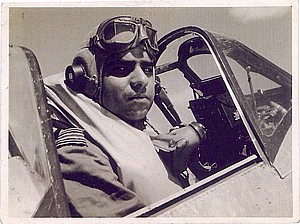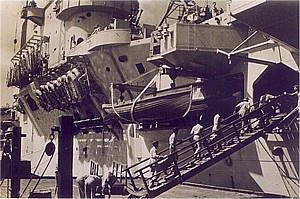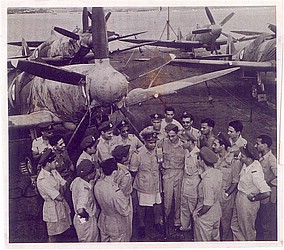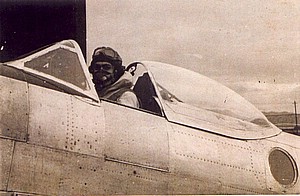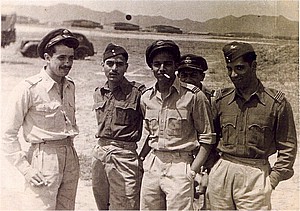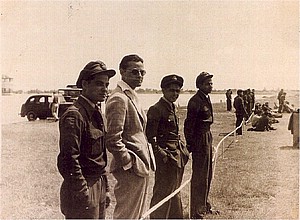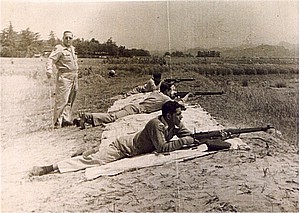IAF Service:
No 4 Squadron, RIAF, had served with distinction in Burma during World War 2 and had only returned to India in April 1945. It had just begun conversion in June from Hurricanes to Spitfires, initially Mk VIII variants. It was then operating out of Yelahanka near Bangalore, the modern-day venue of the Aero-India series of air shows. The Commanding Officer was Squadron Leader D Boyd-Berry, RAF. At the time the squadron had one flight manned by RAF personnel, and the other manned by the RIAF. The respective Flight Commanders were Flight Lieutenants “Mickey” Finn and Nur Khan (later CAS of the Pakistan Air Force).
The unit was Indianised in August 1945 under the command of Squadron Leader Ehrlich W Pinto, one of the small number of Indian aircrew who had served in Europe; and the RAF personnel departed. Unfortunately Sqn Ldr Pinto fell seriously ill in January 1946, and command of the unit was taken over by Squadron Leader Jagdev Chandra, a pre-war regular and operationally-experienced IAF pilot, unassuming-looking but with a reputation that preceded him. Flight Lieutenant “Shippy” Shipurkar was now the second Flight Commander. The Squadron Adjutant was Flight Lieutenant John Rollo (later a Wing Commander with the PAF and Station Commander Chaklala).
“Half my Peshawar course came with me to No 4”, Digby says, including his coursemates FS Hussein and Andy Wiseman. Other pilots with the squadron, who were to achieve distinction later, included:
- Neville Gill, whose father was a colleague of Digby’s father, and who had flown in action with the squadron in Burma;
- Toric Zachariah, later CO of No 7 Squadron during the ’65 war;
- Don Michael, later a long-serving instructor at several IAF flying training establishments, and also at the NDA; and later still OC Flying at Palam during Exercise SHIKSHA;
- Harish “Horace” Saigal; and
- Janmast Afridi, later PAF.
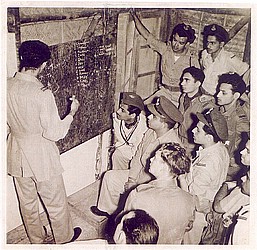 |
‘A’ Flight Office, Yelahanka, c late 1945. Flt Lt Nur Khan at board. Others in picture include Digby, FS Hussein, Toric Zachariah, Neville Gill, Andy Wiseman |
No 4 Squadron was then in the process of converting again, to a higher mark of Spitfires, the Griffon-engined low-backed Mk XIV variant. Its Hurricanes, which it had ferried back from Burma, were intended to be scrapped. RAF personnel in Bangalore were systematically stripping the old Hurricanes of useful equipment, particularly their radios – in many cases not to return to service, but to sell for their own profit. Looting as an end-of-war phenomenon, it has to be said, did not begin in Iraq.
Japan, 1946
Imagine a coalition air force consisting of American, Australian, British and Indian fighter squadrons, operating from airbases close to a city devastated by nuclear strike, patrolling the seas around the Korean peninsula. This is not a fictional scenario from the latest Humphrey Hawksley or Tom Clancy techno-thriller – it was actually happening, 57 years ago.
In early 1946 No 4 Squadron, Royal Indian Air Force, was selected to go to Japan as part of the British Commonwealth Occupation Forces. The selected contingent numbered 40 officers, of whom 25 were pilots. Seven of those 25 were the new Pilot Officers.
It was decided that the squadron would ferry its aircraft from Bangalore to Cochin (now Kochi), where they would embark for the voyage on a Royal Navy aircraft-carrier. The squadron was told that they would not have to land on the carrier – their aircraft would be loaded on – but they might have to take off from the carrier when they reached Japan. They therefore fitted wingtip extensions onto their aircraft (which were otherwise clipped-wing variants), and developed wooden pegs to hold the flaps in a suitable position for short take-offs. They practised short take-offs, until they could all take off within 200 yards.
BN Surendra, one of the Indian DFC awardees, brought a case of Scotch to the squadron the night before they were due to ferry their aircraft to Cochin. It was 1st April, Air Force Day, and an occasion for celebration; and the pilots may have, ill-advisedly, sat up and finished Surendra’s gift.
Pilots and aircraft set out for Cochin the next day, 2nd April. The first section of four aircraft was led by Flying Officer WR Dani flying NH795. On approaching to land at Cochin, which had a short runway with grass on the approach, he hit telegraph wires and overturned. He survived the crash, but suffered glycol burns and could not travel with the rest of the squadron to Japan. (WR Dani was later to command No 5 Squadron when they converted to Canberras, and to retire after a distinguished career as an Air Vice Marshal.)
At Cochin, there was a batch of brand-new Vought Corsairs, American-built carrier-borne fighters that had been provided to the Royal Navy Fleet Air Arm under Lend-Lease. They were so new that they still had brown-paper coverings on their instruments; but as they were Lend-Lease aircraft, they were required to be scrapped, now that the war was over. Again, RAF and FAA personnel were surreptitiously and systematically stripping them of their radios. The RAF Station Commander caught on, and announced a general amnesty if all the stolen radios were returned and placed “outside my office by tomorrow morning.” Whatever the alternative it can’t have been pleasant; Digby recalls that most of the radios were in fact returned by the deadline.
Ironically, the Corsairs were disposed of, in keeping with the requirements of Lend-Lease, not long afterwards. 30 of them, together with FAA Types as Corsairs and Helldats, were actually loaded onto the same aircraft carrier as No 4 Squadron, and were simply pushed overboard once the ship had reached deep water.
At Cochin, Digby and his squadron mates also had their first sight of the aircraft-carrier that was to take them to Japan, HMS Vengeance (Pennant No R71). It was a Colossus-class fleet carrier of 17,000 tons displacement (roughly the same size as the INS Vikrant, although belonging to an earlier period). Her captain, Digby recalls, had served at the Battle of the River Plate.
The squadron’s Spitfires were wheeled to the dockside jetty by road, and loaded onto the carrier by crane.
When the squadron personnel formed up to board the ship, they came up against a piquant little matter of naval protocol – in the Navy officers do not carry their own bags aboard. The RN had assumed that the embarking squadron’s airmen would carry the bags aboard, but the RIAF airmen, most of whom were highly-educated technical personnel, refused to carry the officers’ luggage. (They had the full support of their officers in this position.) The ship’s company eventually sent a number of ratings to carry the officers’ bags aboard.
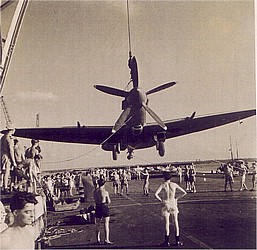 |
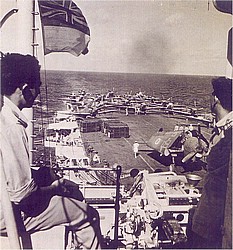 |
| Loading Spitfires aboard | HMS Vengeance shortly after leaving Cochin. Notice the FAA Avenger on the deck. |
After departing Cochin, the ship stopped for three or four days at Singapore, to load two RAF Spitfire squadrons which had previously moved from Burma to Malaya, and a British Army AOP Flight. The two RAF Spitfire squadrons were Nos 11 (a long-serving India-based unit) and 17 (commanded around that time by Squadron Leader JH “Ginger” Lacey, the top-scoring Battle of Britain pilot; also with a record of service in India).
Most of the squadron’s officers and men went ashore at Singapore. Travel was relatively relaxed and informal at that time, and it does not seem that there were any restrictions on going ashore, relating to visas or other travel documentation. For many of the younger among the squadron personnel, it may have been the first time they were setting foot on soil that was not Indian.
Flt Lt Shipurkar, one of the Flight Commanders, literally missed the boat at Singapore – he didn’t get back on board the ship before sailing time. The ship had to send a boat back just for him.
During the voyage, hockey matches were organised on the flight deck between the ship’s company and the RIAF personnel. “Great stuff!!” Digby comments with feeling, looking at the photographs. “Why, were they rough?” I asked. “Absolute goondas!!” Digby twinkled across the table.
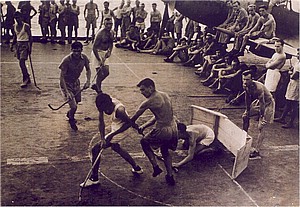 |
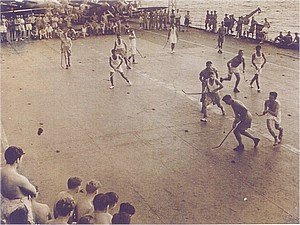 |
| Hockey on the flight deck – “Absolute Goondas!” | |
The voyage took two weeks, from Cochin to Iwakuni, on the Japanese island of Kyushu. The weather became distinctly rougher, as they approached Japan. They arrived at Iwakuni on 23 April 1946.
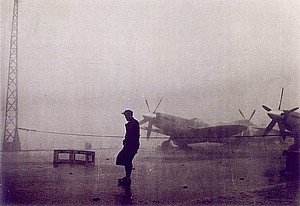 |
Deteriorating weather |
| On board HMS Vengeance, Officers’ Wardroom. Mid front is Cecil Digby, immediately to his left “Horace” Saigal, followed by Rampal, and Jeff Carlton. The rest are RN officers. | 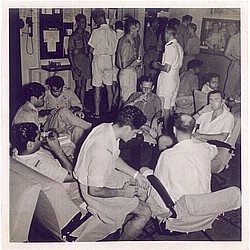 |
On making landfall in Japan, in the event, it was decided that the Spitfires would not attempt to take off from the carrier, because the deck was too crowded, with the three fighter squadrons and the AOP Flight. The aircraft were unloaded and taken ashore by barge.
The Spitfires then had to be de-inhibited – the squadron’s technicians had to work long hours to do so.
Again there was no briefing or familiarisation, on the layout of their new airfield, or anything like that – they were simply sent straight out to fly. And this in a foreign country!
The squadron flew for a short period from Iwakuni, their port of landfall. On 7 May 1946 they moved to Miho, 90 miles to the north-east and situated on the West Coast of the main Japanese island of Honshu, which was to be their base for the rest of their stay.
From Miho, it was actually possible to fly to Korean airspace – the distance was just about 200 miles – and they would often do so. One of their primary tasks was in fact to patrol the seas between Japan and Korea, and interdict smugglers and illegal migrants originating from Korea. Japan was at the time (and still remains) highly sensitive about illegal Korean migrants.
Two squadrons of the Royal Australian Air Force, equipped with North American P-51 Mustangs, used to come to Miho periodically for range work. Digby does not remember the squadron numbers, but the Australian fighter squadrons which served with the Occupation Force in Japan were 76, 77 and 82 Squadrons, RAAF. (77 Squadron RAAF was to remain at, and fly out of, Iwakuni, up to and right through the Korean War.)
The Australians appear to have got along well with the Indians. The RIAF had a mess separate from the RAF, although within the same building. The RAAF personnel were billeted in the RAF mess, but (in a sign, possibly, that their palates were already somewhat ahead of the curve) chose to eat and spend their spare time in the adjacent Indian mess. “Good fliers”, Digby says of them, “but rough.” He remembers that one of their Flight Commanders was named Hank Costain, and that some of the personnel composed a rude song about him, which began, “Costain / Is drunk again”! (Author’s Note: We see this as an example of the rough humour of the Australians, not as a comment on later Wg Cdr Costain)
The Mustangs used to do mass formation take-offs. The Spitfires were restricted to taking off in staggered pairs. There were sound technical reasons for this, but it must have rankled!
The RIAF Spitfires, like most RIAF aircraft in the immediate post-WW2 period, were in a natural metal finish. The RAF Spitfires were in camouflage finish. “The Japanese just loved our aircraft”, Digby says; they would polish and polish them lovingly till they shone!
Most of the squadron’s personnel stayed on throughout their stay in Japan. The CO, Sqn Ldr Chandra, handed over to Sqn Ldr Minoo Merwan Engineer, DFC, and returned to India as part of the normal rotation of command, before the end of the year. Pt Off Wiseman returned to India because of the loss of his mother.
Sqn Ldr Engineer was by nature reserved, but would sometimes let his hair down and join in the junior officers’ escapades. Digby was at the receiving end of one such. He used to attend a Catholic church in the nearby village. On Christmas Eve 1946, he went for Midnight Mass, and took a Catholic airman from the MT Section along with him. Probably knowing that Digby would be away for an extended period that night, Sqn Ldr Engineer led a group of the squadron boys in an episode of horse-play, during which they threw Digby’s personal effects out of his room and into the snow.
Digby says gleefully, “I got my own back during the New Year’s Eve party!” He and Anthony “Tony” (aka “Sue”) Suares were good friends, and during the party they stole into Sqn Ldr Engineer’s room and threw his entire bed out of the top floor window. For years afterwards, Engineer was convinced that this deed had been perpetrated by Flt Lt Shipurkar, who was somewhat the worse for his liquid intake of the evening, at the time. (Suares was later to receive a Vir Chakra in Kashmir, a bar to the VrC while flying for the UN in the Congo, serve as CO of No 5 Squadron, and retire as an Air Commodore.)
The squadron spent the entire winter of 1946/47 in Miho. It is not generally realised how cold the Japanese winters can be; and Miho was snow-bound for three months during the winter. Some far-seeing RIAF Logistics officer had ensured that the RIAF brought along chains for the wheels of their MT vehicles. As it turned out, the RAF hadn’t! Digby and some of the squadron personnel had the opportunity to try their hands out at skiing, on nearby slopes.
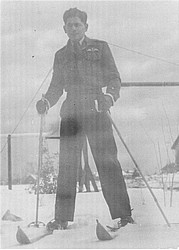 |
Digby and some of the squadron personnel had the opportunity to try their hands out at skiing, on nearby slopes.
|
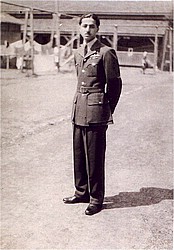 |
Spring returned, and with it better weather, Japanese cherry blossoms, and occasional visitors. As is known, the only fatal accident suffered by the squadron in Japan occurred on 11 June 1947, when Flying Officers GS Sekhon and JA Martin (flying TX979 and SM925 respectively) appear to have flown into high ground while on patrol between Miho and Hiroshima.
The squadron remained based in Miho, Japan from May 1946 till July 1947. By the end of their stay command had changed hands again, to Squadron Leader Maurice “Chuchu” Barker.
Shortly before they were due to leave Japan, the squadron was asked by the Americans, at short notice, to participate in their Fourth of July celebrations. By the time the Americans’ request was received, all 20 of the remaining aircraft had already been inhibited for possible transport. The airmen had to de-inhibit a dozen-odd aircraft within 24 hours. This was no mean achievement. When the airmen had finished, the pilots just did one check each – they had absolute faith in the airmen.
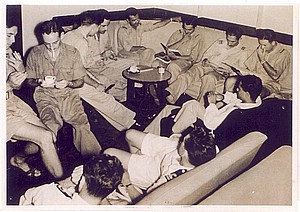 |
|
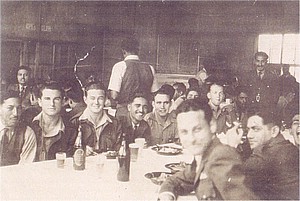 |
For the flypast, the squadron flew to Kisarazu, just outside Tokyo. “We had cartridge starters”, Digby shrugs confidently, so no ground support was required.
On the day of the actual flypast, 4th July 1947, there were many aircraft taxiing and in the air. As was true throughout the war, Spitfires tend to overheat very quickly when their engines are running on the ground, and need to get airborne as quickly as possible after the engine has been started. Stuck in the line of aircraft awaiting permission on the crowded taxiways, one of the squadron’s aircraft overheated beyond the safe limit. The pilot, Fg Off Anthony, sensibly didn’t attempt to take off at all (there would probably have been a reserve aircraft or two among those taking off, so such a decision would not have left a gap in the planned formation), but he didn’t advise his intentions on the R/T. After returning from the flypast the rest of the squadron organised a search party for him, and eventually found him, feet up and none the worse, in the parking bay with his Spitfire.
On their return flight from Kisarazu the CO, Sqn Ldr Barker, called over the R/T that his aircraft was giving trouble. Digby was flying as No 2, and Sqn Ldr Barker ordered him to take over the lead. Barker then left the formation and landed at a diversion airfield in Osaka. Digby was at the time still just a Pilot Officer, and there were many far more experienced pilots in the formation. One of them, “Sue” Suares, left the formation, went to the coast and followed the coastline back to their base. (Otherwise, there was a risk having to let down through cloud, behind a formation leader he probably considered inexperienced in that role.)
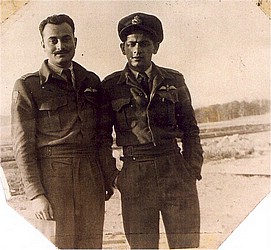 |
 |
In late July 1947, when the time came for the squadron to leave Japan, the personnel went by the troopship HMS Devonshire which bought them back to Madras. Their Spitfires were not brought back to India – Digby believed they were simply abandoned in Japan. Wg Cdr Don Michael, another veteran of service with the squadron in the same period, tells us that the Spitfires were transferred, in what was probably treated as a book transfer of assets between two Commonwealth cost centres, to one of the Australian units there at the time.
The book “Spitfire International” mentions that a number of the aircraft that were on the strength of No 4 Squadron, RIAF were Struck-Off Charge in March 1948:
Source: Spitfire International, History of the Indian Air Force 1933-1947 , Wg Cdr Digby’s Logbook. Aircraft in Red were lost in the accident of Martin and Sekhon. |
Among the trophies that the squadron brought back from Japan is an example of the Yokosuka Ohka kamikaze aircraft, now on display at the Indian Air Force Museum in Delhi.
The two RAF squadrons that had come to Japan with No 4 Squadron were both disbanded at the end of their period of service in Japan. Both re-formed later; 17 Squadron only after many decades of number-plate existence. 11 Squadron RAF today operates Tornado F3s; 17 Squadron RAF is today the Eurofighter Typhoon Operational Evaluation Unit.
Miho today is a Japan Air Self-Defence Force base, home to 3 Yuso Kokutai (3 Tactical Airlift Wing), operating Kawasaki C-1 and NAMC YS-11 (Japanese-built Avro 748) tactical transports. As the JASDF aircrew execute their circuits, and the groundcrews their servicing routines, one wonders if they remember the Australian, British, and Indian personnel who operated from the same base, nearly six decades ago..
